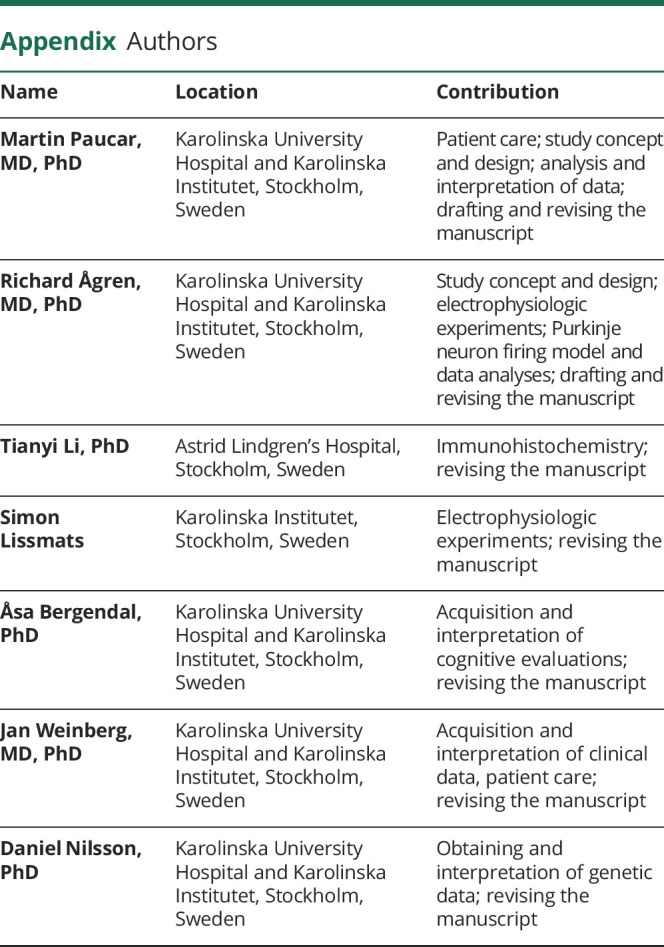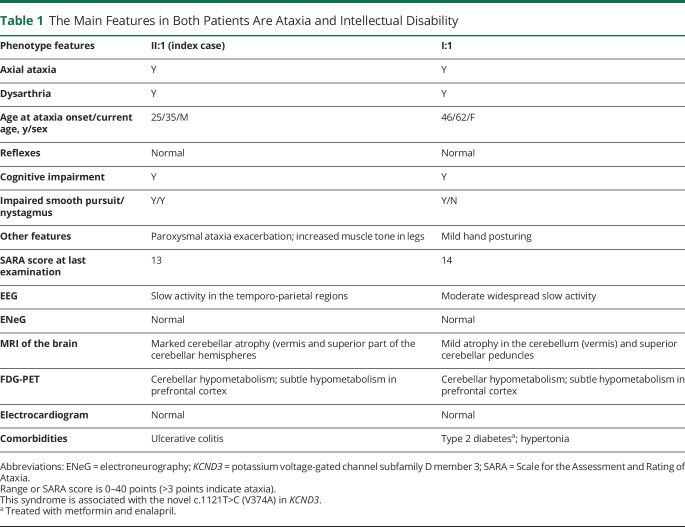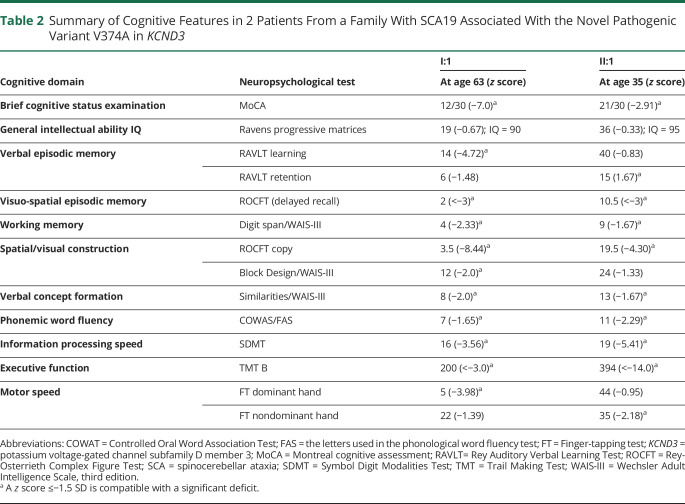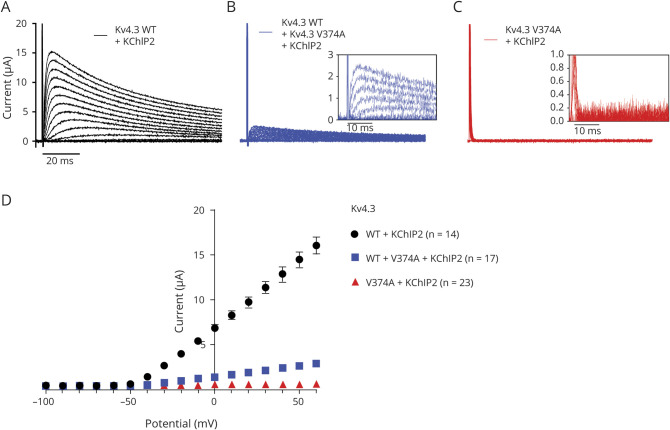Abstract
Objective
Ataxia channelopathies share common features such as slow motor progression and variable degrees of cognitive dysfunction. Mutations in potassium voltage-gated channel subfamily D member 3 (KCND3), encoding the K+ channel, Kv4.3, are associated with spinocerebellar ataxia (SCA) 19, allelic with SCA22. Mutations in potassium voltage-gated channel subfamily C member 3 (KCNC3), encoding another K+ channel, Kv3.3, cause SCA13. First, a comprehensive phenotype assessment was carried out in a family with autosomal dominant ataxia harboring 2 genetic variants in KCNC3 and KCND3. To evaluate the physiological impact of these variants on channel currents, in vitro studies were performed.
Methods
Clinical and psychometric evaluations, neuroimaging, and genotyping of a family (mother and son) affected by ataxia were carried out. Heterozygous and homozygous Kv3.3 A671V and Kv4.3 V374A variants were evaluated in Xenopus laevis oocytes using 2-electrode voltage-clamp. The influence of Kv4 conductance on neuronal activity was investigated computationally using a Purkinje neuron model.
Results
The main clinical findings were consistent with adult-onset ataxia with cognitive dysfunction and acetazolamide-responsive paroxysmal motor exacerbations in the index case. Despite cognitive deficits, fluorodeoxyglucose (FDG)-PET displayed hypometabolism mainly in the severely atrophic cerebellum. Genetic analyses revealed the new variant c.1121T>C (V374A) in KCND3 and c.2012T>C (A671V) in KCNC3. In vitro electrophysiology experiments on Xenopus oocytes demonstrated that the V374A mutant was nonfunctional when expressed on its own. Upon equal co-expression of wild-type (WT) and V374A channel subunits, Kv4.3 currents were significantly reduced in a dominant negative manner, without alterations of the gating properties of the channel. By contrast, Kv3.3 A671V, when expressed alone, exhibited moderately reduced currents compared with WT, with no effects on channel activation or inactivation. Immunohistochemistry demonstrated adequate cell membrane translocation of the Kv4.3 V374A variant, thus suggesting an impairment of channel function, rather than of expression. Computational modeling predicted an increased Purkinje neuron firing frequency upon reduced Kv4.3 conductance.
Conclusions
Our findings suggest that Kv4.3 V374A is likely pathogenic and associated with paroxysmal ataxia exacerbations, a new trait for SCA19/22. The present FDG PET findings contrast with a previous study demonstrating widespread brain hypometabolism in SCA19/22.
Heterozygous mutations in potassium voltage-gated channel subfamily D member 3 (KCND3), encoding the voltage-dependent potassium channel Kv4.3, are associated with spinocerebellar ataxia (SCA) 19, allelic with SCA22.1–3 So far, only 10 articles describing patients with SCA19/22 have been published.2–10 The phenotype is variable and includes, besides ataxia, other movement disorders, variable degrees of cognitive impairment and epilepsy.1–10 The only fluorodeoxyglucose (FDG) PET study on SCA19 demonstrated widespread hypometabolism.9 Genetic variants in KCND3 are also associated with cardiac arrhythmia and sudden unexpected death (SUD).4,11,12
Functional analyses of some of the KCND3 mutations demonstrated either channel dysfunction or reduced cell membrane trafficking.2–5,10,13 These abnormalities are often attenuated by co-expression of potassium channel interacting protein 2 (KChIP2).4,5,10,13 Here, we report 2 members of a family affected by ataxia and intellectual disability associated with the new V374A variant in KCND3. In addition, the index case suffered from paroxysmal ataxia exacerbations responsive to acetazolamide (ACZ). Our results demonstrate a downscaling of current upon co-expression of wild-type (WT) Kv4.3 with the V374A mutant compared with WT Kv4.3 expressed alone, suggesting a decreased expression of functional channels in the membrane.
Methods
Both patients provided written and oral consent to this study approved by the ethical committee in Stockholm. Clinical assessment included examination with Scale for Assessment and Rating of Ataxia, Index of Non-Ataxia Symptoms, psychometric testing, and neuroimaging. Neuroimaging included MRI and 18F-FDG PET, whereas psychometric evaluation included a comprehensive test battery (e-Methods, links.lww.com/NXG/A357). The index case was investigated with massive parallel sequencing and candidate variants verified with Sanger sequencing. Injection of complementary RNA encoding channel subunits into Xenopus laevis oocytes and subsequent oocyte voltage-clamp recordings were performed as described previously.14 Finally, a computational analysis of the mutational effects of Kv4.3 channels on a Purkinje neuron model was performed using the program NEURON7.7.15,16 Briefly, this model incorporates resurgent and nonresurgent Nav channels, Kv1, Kv3, Kv4 channels, P-type calcium channels, calcium-activated Kv channels, hyperpolarization-activated cation channels, and leak currents (e-Methodshttp://links.lww.com/NXG/A357).
Immunocytochemistry
HEK293T cells were transfected according to previous descriptions,2,3 the mean fluorescence density of Alexa Fluor 633 of whole cell body, membrane (Fm), and cytoplasm (Fc), and the Fm/Fc ratio was calculated (e-Methods, links.lww.com/NXG/A357).
Data Availability
Anonymized data will be shared by the investigators upon request.
Results
Clinical Findings
Two patients, mother and son, in a Swedish family were diagnosed with adult-onset slowly progressive cerebellar ataxia and bradyphrenia (figure e-1, links.lww.com/NXG/A348). Both patients were also diagnosed with learning difficulties (table 1) and have attended special schools. Common features for these patients include normal general intellectual ability despite low results in cognitive screening tests. Low performance in the following cognitive domains was evident in both patients: information processing speed, visuo-spatial episodic memory, spatial/visual construction, verbal concept formation, phonemic word fluency, and executive function (table 2). Despite these deficits, IQ scores were 90 and 95, respectively. The index case (II:1) is a 35-year-old man who suffered from paroxysmal ataxia exacerbations when exposed to accelerations/decelerations, such as when riding an elevator, bus, or train. These episodes, witnessed in 2 occasions by 2 of the authors (J.W. and M.P.), were responsive to ACZ. Patient II:1 was also treated with clonazepam and mesalamine, and the latter was for ulcerative colitis. Patient I:1 (62 years old) was not treated with any psychotropic drugs. Cerebellar atrophy was severe in the index case and milder in patient I:1; in both cases, FDG PET demonstrated moderate-to-severe hypometabolism in the cerebellum (vermis and upper cerebellar hemispheres) and subtle hypometabolism in the prefrontal cortex (figure e-2, links.lww.com/NXG/A349). We did not find evidence of parkinsonism, epilepsy, polyneuropathy, cardiac signs, or arrhythmias.
Table 1.
The Main Features in Both Patients Are Ataxia and Intellectual Disability
Table 2.
Summary of Cognitive Features in 2 Patients From a Family With SCA19 Associated With the Novel Pathogenic Variant V374A in KCND3
Genetic Analyses
Pathologic CAG expansions associated with SCA 1, 2, 3, 6, 7, dentatorubropallidoluysian atrophy as well as copy number variations were ruled out in the index case. Both patients carry the variants c.1121T>C (V374A) in KCND3 and c.2012T>C (A671V) in potassium voltage-gated channel subfamily C member 3 (KCNC3). The variant c.1121T>C (V374A) in KCND3 has not been reported before, whereas c.2012T>C (A671V) in KCNC3 has a minor allele frequency = 0.00016% in the European population (e-Methods, links.lww.com/NXG/A357). Heterozygous variants in KCNC3 are associated with SCA13; therefore, we hypothesize a synergistic effect of the 2 K+ channel variants.
In Vitro Studies
Kv4.3 V374A Disrupts Potassium Conductance
Oocytes injected with complementary RNA encoding Kv4.3 + KChIP2 (WT:V374A, 1:0) exhibited peaked currents with swift N-type inactivation (figure 1A), consistent with previous descriptions of Kv4.3 currents.17 Cells expressing Kv4.3 + Kv4.3 V374A + KChIP2 (WT:V374A, 0.5:0.5) showed smaller currents maintaining the peaked character without shifting the voltage dependence of channel activation (figure 1B) or inactivation (figure e-3, links.lww.com/NXG/A350). In cells expressing Kv4.3 V374A + KChIP2 (WT:V374A, 0:1) alone, virtually no voltage-dependent currents were observed (figure 1C). WT:V374A, 0.5:0.5 demonstrated an average peak current reduction of ∼80% as compared to WT:V374A, 1:0 (figure 1D). A simple scaling effect suggests a reduction of functional Kv4.3 channels in the membrane, with no effect of the V374A mutation on conductance or inactivation curves (figure e-3http://links.lww.com/NXG/A350). Conversely, expression of Kv3.3 + A671V (WT:A671V, 0.5:0.5) resulted in currents similar to those of cells expressing Kv3.3 WT (WT:A671V, 1:0) alone, whereas Kv3.3 A671V (WT:A671V, 0:1) alone exhibited slightly reduced currents compared with WT (figure e-4, links.lww.com/NXG/A351). Again, for A671V, no effects were observed on activation or inactivation curves (figure e-5, links.lww.com/NXG/A352). Application of 100 μM ACZ to oocytes expressing Kv4.3 + Kv4.3 V374A, 1:0, 0.5:0.5, or 0:1, respectively, did not modify the currents (data not shown).
Figure 1. Kv4.3 WT/V374A/KChIP2 Currents and I-V Relationships.
(A) Representative traces of Kv4.3 WT:V374A (1:0). (B) Representative traces of Kv4.3 WT:V374A (0.5:0.5). Inset demonstrates first 40 ms at voltage increments of 20 mV (between −100 and +60 mV). (C) Representative traces of WT:V374A (0:1). Inset demonstrates first 40 ms at voltage increments of 20 mV (between −100 and +60 mV). (D) I-V relationships for (A–C) measured at the peak current. The holding potential was −100 mV. Voltage steps of 10 mV during 1,000 ms. The interpulse interval was 5 seconds. KChIP2 = potassium channel interacting protein 2; WT = wild-type.
Kv4.3 Channel Modulates Purkinje Neuron Excitability
The effect of reducing the number of functional Kv4.3 channels on neuronal excitability was analyzed using a Purkinje neuron model incorporating Kv1, Kv3, and Kv4 channels.15 Based on the similar kinetic properties of Kv4.3 + Kv4.3 V374A, 1:0 and 0.5:0.5, the maximum Kv4 conductance (Kv4 bar) was reduced according to the I-V relationships (figure 1D). In contrast to the WT:V374A, 1:0, the WT:V374A, 0.5:0.5 model demonstrated lower action potential amplitudes and higher firing frequency, indicating modified excitability properties18 (figure e-6A, links.lww.com/NXG/A353). Action potential slope analysis corroborated the dynamic differences induced by WT:V374A, 0.5:0.5, with a slower increase in voltage for the reduced amplitude action potentials (figure e-6Bhttp://links.lww.com/NXG/A353). The firing frequency was increased 2.9-fold by WT:V374A, 0.5:0.5, compared with 1:0, and detailed analysis of peak amplitudes revealed a 22 mV reduction for 0.5:0.5 (figure e-6, C and Dhttp://links.lww.com/NXG/A353). Also, peak width and hyperpolarization were increased for WT:V374A, 0.5:0.5 (figure e-6, E and Fhttp://links.lww.com/NXG/A353).
Immunohistochemistry
HEK293T cells transiently transfected to express Kv4.3 WT:V374A, 1:0, 0.5:0.5, and 0:1, separately, displayed a high level of Kv4.3 protein at the cell surface. The Fm/Fc ratio of Kv4.3 WT protein remained at a similar level with or without Kv4.3 V374A (figure e-7, links.lww.com/NXG/A354).
Discussion
Paroxysmal ataxia exacerbations responsive to ACZ and the KCND3 variant V374A are new findings for SCA19. Hypometabolism limited to the cerebellum is unexpected, considering the range of cognitive deficits in this family. These findings contrast with the widespread brain hypometabolism in another SCA19 family.9 In our studies, the failure of the Kv4.3 V374A mutant to produce appreciable Kv4.3 currents when expressed alone, along with the conservation of WT channel kinetic properties in the face of a downscaling of current amplitudes, suggests a reduction of functional WT Kv4.3 channels in the membrane upon co-expression with the mutant channel. Our findings neither support a synergistic effect between Kv4.3 V374A and Kv3.3 A671V. However, some caution is required since heterologous expression systems such as Xenopus oocytes may not completely mirror mammalian expression and/or trafficking of ion channels.
Kv4 channels are made of up 4 alpha subunits (figure e-8, links.lww.com/NXG/A355)19; thus, incorporation of mutant subunits that are incompatible with channel function can be expected to decrease the number of functional channels by more than 50% (i.e., a dominant-negative effect).20 The Kv4.3 V374A variant is located in the pore loop between transmembrane helices S5 and S6 near the selectivity filter; the part of the protein forming the ion conduction pathway, crucial to the channel's ability to pass current. Of interest the majority of the 13 reported pathogenic variants in KCND3 associated with SCA19 are located in the pore loop or in the nearby extracellular ends of S5 and S6 (figure e-6, links.lww.com/NXG/A353). Judging by our immunohistochemistry data, V374A appears to be localized to the cell membrane, contrary to other pathogenic KCND3 variants.2,3 Despite the relatively conservative amino acid substitution, the V374A variant reduced Kv4.3 peak currents by ∼81% when co-expressed at a 0.5:0.5 ratio with WT Kv4.3 subunits, consistent with a dominant-negative effect. In comparison, the SCA19/22-associated Kv4.3 T352P variant, in the presence of 1:1 KChIP2, has been suggested to reduce the peak current by 52%.13 Of interest the adjacent pathogenic variant Kv4.3 M373I, also in the presence of KChIP2, did not affect the expression level in oocytes as measured by current amplitudes.13 Given its critical location, it may be that the V374A mutation perturbs the ability of the channel to conduct potassium ions.
KCND3 mutations are also associated with arrhythmia and SUD. We hypothesize that gain-o- function (GOF) variants, reported for SUD, mainly influence the cardiac action potential, whereas loss-of-function (LOF) variants, associated with SCA19/22, mainly modulate neuronal excitability. Purkinje neuron simulations with a 80% reduction of Kv4.3 channel conductance (e.g., 0.5:0.5, WT:V374A) demonstrated rapid firing, whereas corresponding simulations with only a slightly increased Kv4.3 channel conductance (103%; corresponding to GOF mutations) demonstrate reduced firing frequencies (and no firing with further increased Kv4 conductance). The increase in firing frequency following Kv4.3 inhibition is in line with previous pharmacologic and genetic experiments with dopamine21 and pyramidal neurons, respectively.22 By contrast, a ventricular cell model23 exhibited slightly shortened action potentials following ∼80% reduction in the number of Kv4 channels, whereas a 50%–100% increase in Kv4 channels, corresponding to GOF variants, prolonged the action potentials substantially11 (figure e-9, links.lww.com/NXG/A356). Hypothetically, KChIP2 may be involved in regulating the Kv4.3 expression in pathologic conditions—for GOF (LOF) variants, reduced (increased) KChIP2 levels may decrease (increase) the number of Kv4.3 channels. Theoretically, such differences may explain why concomitant ataxia and arrhythmia have not been reported. Expression of KChIP2 has recently been demonstrated to modulate the balance between Kv4.3 and voltage-gated sodium channel 5 (Nav1.5).24 However, the GOF variant Kv4.3 L450F has been reported separately in a patient with Brugada syndrome25 and a patient with ataxia,4 illustrating the complexity in elucidating genotype-phenotype correlations for KCND3.
Although ACZ demonstrated clinical efficacy in the index case, no in vitro effects were observed on Kv4.3 V374A. Instead, carbonic anhydrase inhibition by ACZ and subsequent pH reduction could indirectly modulate ion channels, thereby possibly mediating the therapeutic effect and attenuating paroxysmal ataxia exacerbations. Decreased neuronal excitability in numerous SCAs associated with LOF variants (SCA27—indirectly Nav1.6, SCA13—Kv3.3, and SCA6—Cav2.1) has been described.26 For Kv4.3 LOF, increased Purkinje neuron excitability was observed in the simulations. Based on this, evaluation of drugs reducing neuronal excitability, e.g., Nav channel blockers, in a Kv4.3 LOF model may provide further insights of therapeutic relevance.
Acknowledgment
The authors are grateful to the patients for their kind participation in this study. They are also grateful to the Follin Foundation for supporting M. Paucar's research.
Glossary
- ACZ
acetazolamide
- Fc
fluorescence density of Alexa Fluor 633 cytoplasm
- FDG
fluorodeoxyglucose
- Fm
fluorescence density of Alexa Fluor 633 membrane
- GOF
gain of function
- KCNC3
potassium voltage-gated channel subfamily C member 3
- KCND3
potassium voltage-gated channel subfamily D member 3
- KChIP2
potassium channel interacting protein 2
- LOF
loss of function
- SCA
spinocerebellar ataxia
- SUD
sudden unexpected death
- WT
wild-type
Appendix. Authors

Contributor Information
Richard Ågren, Email: richard.agren@ki.se.
Tianyi Li, Email: tianyi.li@ki.se.
Simon Lissmats, Email: simonlissmats@hotmail.com.
Åsa Bergendal, Email: asa.bergendal@ki.se.
Jan Weinberg, Email: jnt.weinberg@gmail.com.
Daniel Nilsson, Email: daniel.nilsson@ki.se.
Irina Savichetva, Email: irina.savitcheva@sll.se.
Kristoffer Sahlholm, Email: kristoffer.sahlholm@ki.se.
Johanna Nilsson, Email: johanna.nilsson.1@ki.se.
Per Svenningsson, Email: per.svenningsson@ki.se.
Study Funding
The authors report no targeted funding.
Disclosure
The authors report no disclosures relevant to the manuscript. Go to Neurology.org/NG for full disclosures.
References
- 1.Schelhaas HJ, Ippel PF, Hageman G, et al. . Clinical and genetic analysis of a four-generation family with a distinct autosomal dominant cerebellar ataxia. J Neurol 2001;248:113–120. 10.1007/s004150170245. [DOI] [PubMed] [Google Scholar]
- 2.Duarri A, Jezierska J, Fokkens M, et al. . Mutations in potassium channel kcnd3 cause spinocerebellar ataxia type 19. Ann Neurol 2012;72:870–880. 10.1002/ana.23700. [DOI] [PubMed] [Google Scholar]
- 3.Lee YC, Durr A, Majczenko K, et al. . Mutations in KCND3 cause spinocerebellar ataxia type 22. Ann Neurol 2012;72:859–869. 10.1002/ana.23701. [DOI] [PMC free article] [PubMed] [Google Scholar]
- 4.Duarri A, Nibbeling E, Fokkens MR, et al. . The L450F [Corrected] mutation in KCND3 brings spinocerebellar ataxia and Brugada syndrome closer together. Neurogenetics 2013;14:257–258. 10.1007/s10048-013-0370-0. [DOI] [PubMed] [Google Scholar]
- 5.Smets K, Duarri A, Deconinck T, et al. . First de novo KCND3 mutation causes severe Kv4.3 channel dysfunction leading to early onset cerebellar ataxia, intellectual disability, oral apraxia and epilepsy. BMC Med Genet 2015;16:51 10.1186/s12881-015-0200-3. [DOI] [PMC free article] [PubMed] [Google Scholar]
- 6.Coutelier M, Coarelli G, Monin ML, et al. . A panel study on patients with dominant cerebellar ataxia highlights the frequency of channelopathies. Brain 2017;140:1579–1594. 10.1093/brain/awx081. [DOI] [PubMed] [Google Scholar]
- 7.Huin V, Strubi-Vuillaume I, Dujardin K, et al. . Expanding the phenotype of SCA19/22: parkinsonism, cognitive impairment and epilepsy. Parkinsonism Relat Disord 2017;45:85–89. 10.1016/j.parkreldis.2017.09.014. [DOI] [PubMed] [Google Scholar]
- 8.Kurihara M, Ishiura H, Sasaki T, et al. . Novel de novo KCND3 mutation in a Japanese patient with intellectual disability, cerebellar ataxia, myoclonus, and dystonia. Cerebellum 2018;17:237–242. 10.1007/s12311-017-0883-4. [DOI] [PubMed] [Google Scholar]
- 9.Paucar M, Bergendal Å, Gustavsson P, et al. . Novel features and abnormal pattern of cerebral glucose metabolism in spinocerebellar ataxia 19. Cerebellum 2018;17:465–476. 10.1007/s12311-018-0927-4. [DOI] [PMC free article] [PubMed] [Google Scholar]
- 10.Hsiao CT, Fu SJ, Liu YT, et al. . Novel SCA19/22-associated KCND3 mutations disrupt human KV 4.3 protein biosynthesis and channel gating. Hum Mutat 2019;40:2088–2107. 10.1002/humu.23865. [DOI] [PubMed] [Google Scholar]
- 11.Giudicessi JR, Ye D, Kritzberger CJ, et al. . Novel mutations in the KCND3-encoded Kv4.3 K+ channel associated with autopsy-negative sudden unexplained death. Hum Mutat 2012;33:989–997. 10.1002/humu.22058. [DOI] [PMC free article] [PubMed] [Google Scholar]
- 12.Takayama K, Ohno S, Ding WG, et al. . A de novo gain-of-function KCND3 mutation in early repolarization syndrome. Heart Rhythm 2019;16:1698–1706. 10.1016/j.hrthm.2019.05.033. [DOI] [PubMed] [Google Scholar]
- 13.Duarri A, Lin MC, Fokkens MR, et al. . Spinocerebellar ataxia type 19/22 mutations alter heterocomplex Kv4.3 channel function and gating in a dominant manner. Cell Mol Life Sci 2015;72:3387–3399. 10.1007/s00018-015-1894-2. [DOI] [PMC free article] [PubMed] [Google Scholar]
- 14.Papke RL, Stokes C. Working with OpusXpress: methods for high volume oocyte experiments. Methods 2010;51:121–133. 10.1016/j.ymeth.2010.01.012. [DOI] [PMC free article] [PubMed] [Google Scholar]
- 15.Akemann W, Knöpfel T. Interaction of Kv3 potassium channels and resurgent sodium current influences the rate of spontaneous firing of Purkinje neurons. J Neurosci 2006;26:4602–4612. 10.1523/JNEUROSCI.5204-05.2006. [DOI] [PMC free article] [PubMed] [Google Scholar]
- 16.Carnevale NT, Hines ML. The NEURON Book. Cambridge: Cambridge University Press; 2006. [Google Scholar]
- 17.Patel SP, Campbell DL, Strauss HC. Elucidating KChIP effects on Kv4.3 inactivation and recovery kinetics with a minimal KChIP2 isoform. J Physiol 2002;545:5–11. 10.1113/jphysiol.2002.031856. [DOI] [PMC free article] [PubMed] [Google Scholar]
- 18.Izhikevich EM Dynamical Systems in Neuroscience. Cambridge: MIT Press; 2007. [Google Scholar]
- 19.Parcej DN, Scott VE, Dolly JO. Oligomeric properties of alpha-dendrotoxin-sensitive potassium ion channels purified from bovine brain. Biochemistry 1992;31:11084–11088. 10.1021/bi00160a018. [DOI] [PubMed] [Google Scholar]
- 20.Herskowitz I Functional inactivation of genes by dominant negative mutations. Nature 1987;329:219–222. 10.1038/329219a0. [DOI] [PubMed] [Google Scholar]
- 21.Liss B, Franz O, Sewing S, Bruns R, Neuhoff H, Roeper J. Tuning pacemaker frequency of individual dopaminergic neurons by Kv4.3L and KChip3.1 transcription. EMBO J 2001;20:5715 10.1093/emboj/20.20.5715. [DOI] [PMC free article] [PubMed] [Google Scholar]
- 22.Carrasquillo Y, Burkhalter A, Nerbonne JM. A-type K+ channels encoded by Kv4.2, Kv4.3 and Kv1.4 differentially regulate intrinsic excitability of cortical pyramidal neurons. J Physiol 2012;590:3877–3890. 10.1113/jphysiol.2012.229013. [DOI] [PMC free article] [PubMed] [Google Scholar]
- 23.Hund TJ, Rudy Y. Rate dependence and regulation of action potential and calcium transient in a canine cardiac ventricular cell model. Circulation 2004;110:3168–3174. 10.1161/01.CIR.0000147231.69595.D3. [DOI] [PMC free article] [PubMed] [Google Scholar]
- 24.Clatot J, Neyroud N, Cox R, et al. . Inter-regulation of K(v)4.3 and voltage-gated sodium channels underlies predisposition to cardiac and neuronal channelopathies. Int J Mol Sci 2020;21:4908 10.3390/ijms21144908. [DOI] [PMC free article] [PubMed] [Google Scholar]
- 25.Giudicessi JR, Ye D, Tester DJ, et al. . Transient outward current (I(to)) gain-of-function mutations in the KCND3-encoded Kv4.3 potassium channel and Brugada syndrome. Heart Rhythm 2011;8:1024–1032. 10.1016/j.hrthm.2011.02.021. [DOI] [PMC free article] [PubMed] [Google Scholar]
- 26.Hoxha E, Balbo I, Miniaci MC, et al. . Purkinje cell signaling deficits in animal models of ataxia. Front Synaptic Neurosci 2018;10:6 10.3389/fnsyn.2018.00006. [DOI] [PMC free article] [PubMed] [Google Scholar]
Associated Data
This section collects any data citations, data availability statements, or supplementary materials included in this article.
Data Availability Statement
Anonymized data will be shared by the investigators upon request.





